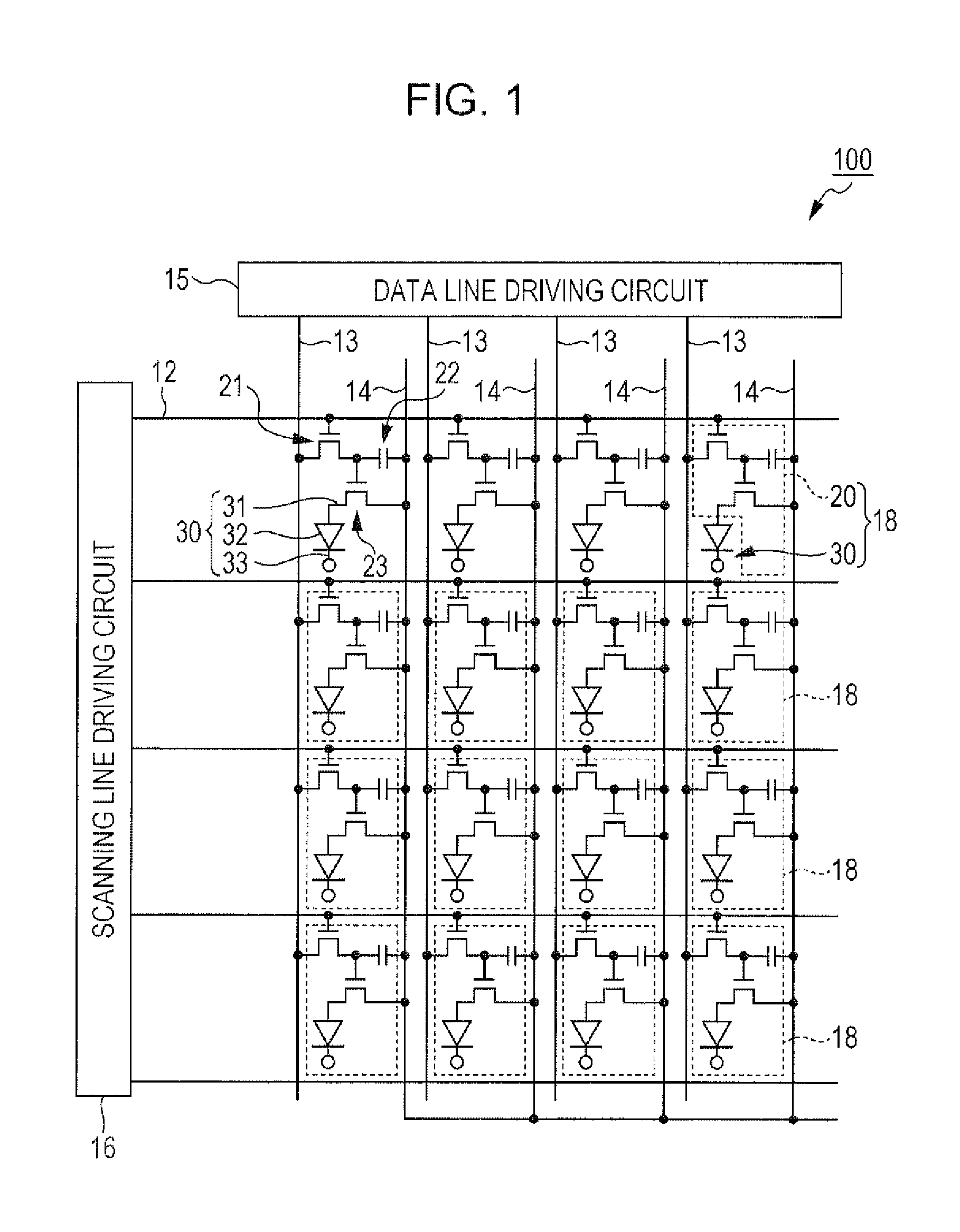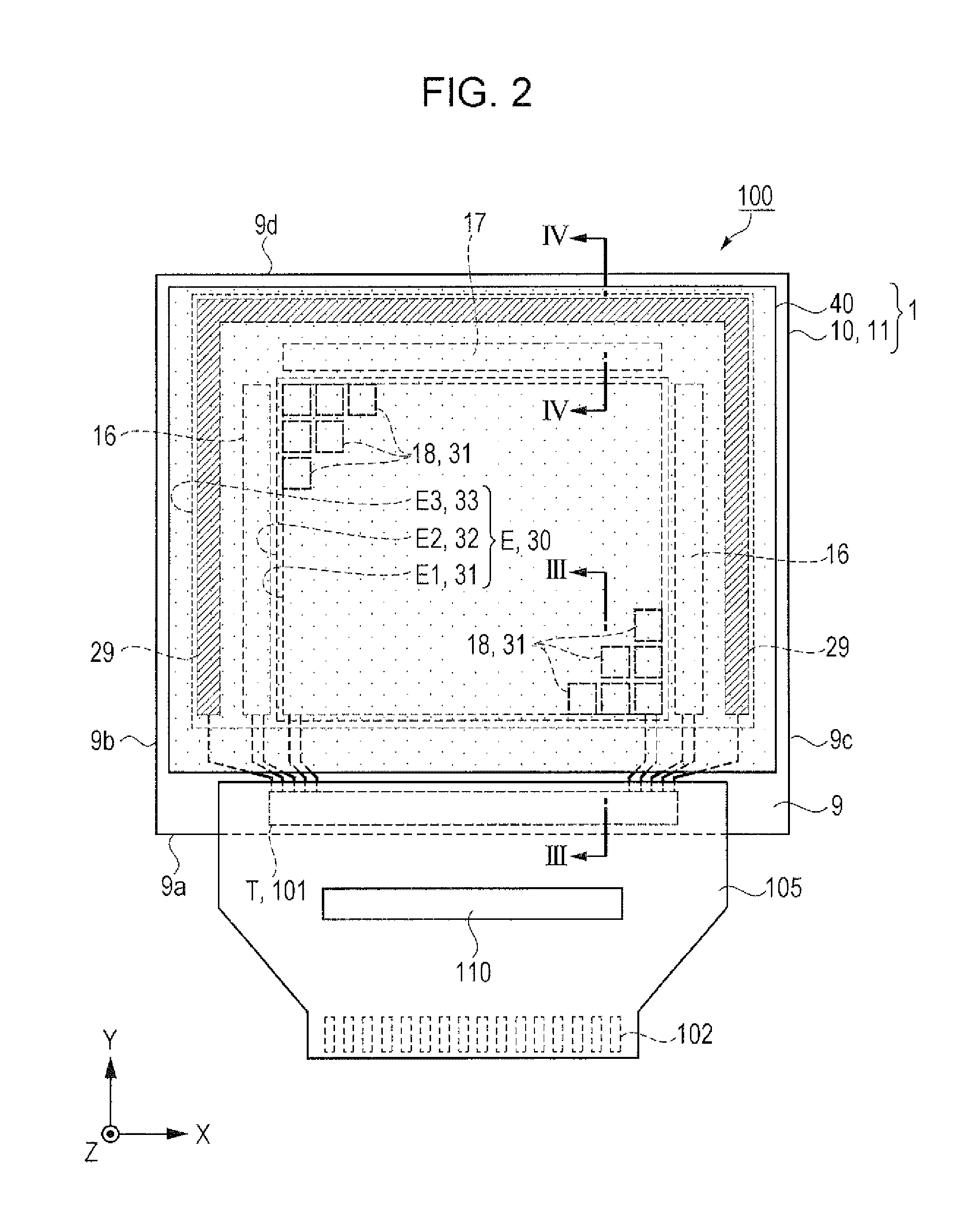Electro-optic device, method of manufacturing electro-optic device, and electronic apparatus
a manufacturing method and electrooptic technology, applied in the direction of solid-state devices, semiconductor devices, thermoelectric devices, etc., can solve the problems of difficult to completely block the influence of moisture, and cracks are more likely to be generated in inorganic compound films. , to achieve the effect of reducing the influence of stress on segmentation along the segmentation lin
- Summary
- Abstract
- Description
- Claims
- Application Information
AI Technical Summary
Benefits of technology
Problems solved by technology
Method used
Image
Examples
first embodiment
Outline of Organic EL Device
[0064]An organic EL device 100 according to a first embodiment is an example of an electro-optic device, displays a monochrome image, and can be suitably used in a display unit such as a head mounted display (HMD) to be described later or a digital camera.
[0065]First, an outline of the organic EL device 100 according to this embodiment will be described with reference to FIGS. 1 and 2. FIG. 1 is an equivalent circuit diagram showing the electrical configuration of the organic EL device according to this embodiment. FIG. 2 is a schematic plan view showing the configuration of the organic EL device according to this embodiment.
[0066]As shown in FIG. 1, the organic EL device 100 according to this embodiment includes a plurality of scanning lines 12 and a plurality of data lines 13 which cross each other, and a plurality of power lines 14 which are arrayed in parallel with the respective plurality of data lines 13. The scanning lines 12 are connected to a sca...
second embodiment
Outline of Organic EL Device
[0163]FIG. 10 is a schematic plan view showing the configuration of an organic EL device according to a second embodiment. FIG. 11 is a schematic cross-sectional view showing the structure of the organic EL panel taken along line XI-XI (green (G) colored layer) of FIG. 10. FIG. 12 is a schematic cross-sectional view showing the structure of the organic EL panel taken along line XII-XII (region in which a green colored layer is disposed) of FIG. 10. FIG. 13 is a schematic plan view of a terminal region.
[0164]Hereinafter, an organic EL device 200 according to this embodiment will be described with reference to FIGS. 10 to 13 focusing on the differences from the first embodiment. In addition, the same components as those in the first embodiment will be denoted by the same reference numerals, and repeated description will be omitted.
[0165]The main differences between this embodiment and the first embodiment are that the organic EL device 200 (an organic EL pa...
third embodiment
[0180]FIG. 14 corresponds to FIG. 2 and is a schematic plan view of an organic EL device according to a third embodiment. FIG. 15 corresponds to FIG. 4 and is a schematic cross-sectional view showing the structure of the organic EL panel taken along line XV-XV of FIG. 14.
[0181]Hereinafter, an organic EL device 300 according to this embodiment will be described with reference to FIGS. 14 and 15 focusing on the differences from the first embodiment. In addition, the same components as those in the first embodiment will be denoted by the same reference numerals, and repeated description will be omitted.
[0182]In the organic EL device 300 according to this embodiment, the shape (size) of a protection substrate 40 is different from that in the first embodiment, and other configurations are the same as those in the first embodiment.
[0183]In the first embodiment, the protection substrate 40 is attached to each of the plurality of element substrates 10 using a method of attaching the simplex...
PUM
 Login to View More
Login to View More Abstract
Description
Claims
Application Information
 Login to View More
Login to View More - R&D
- Intellectual Property
- Life Sciences
- Materials
- Tech Scout
- Unparalleled Data Quality
- Higher Quality Content
- 60% Fewer Hallucinations
Browse by: Latest US Patents, China's latest patents, Technical Efficacy Thesaurus, Application Domain, Technology Topic, Popular Technical Reports.
© 2025 PatSnap. All rights reserved.Legal|Privacy policy|Modern Slavery Act Transparency Statement|Sitemap|About US| Contact US: help@patsnap.com



